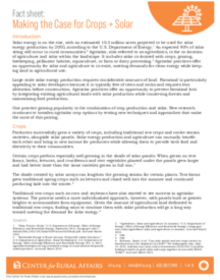Solar energy is on the rise, with an estimated 10.3 million acres projected to be used for solar energy production by 2050, according to the U.S. Department of Energy. An expected 90% of solar siting will occur in rural communities. Agrisolar, also referred to as agrivoltaics, is the co-location of agriculture and solar within the landscape. It includes solar co-located with crops, grazing, beekeeping, pollinator habitat, aquaculture, or farm or dairy processing. Agrisolar practices offer an opportunity for solar and agriculture to co-exist, meeting demands for clean energy while keeping land in agricultural use.
Large-scale solar energy production requires considerable amounts of land. Farmland is particularly appealing to solar developers because it is typically free of trees and rocks and requires less alteration before construction. Agrisolar practices offer an opportunity to prevent farmland loss by integrating existing agricultural lands with solar production while conserving forests and maintaining food production.
One practice gaining popularity is the combination of crop production and solar. New research continues to broaden agrisolar crop options by testing new techniques and approaches that make the most of this pairing.
Farm and Food
Policy


